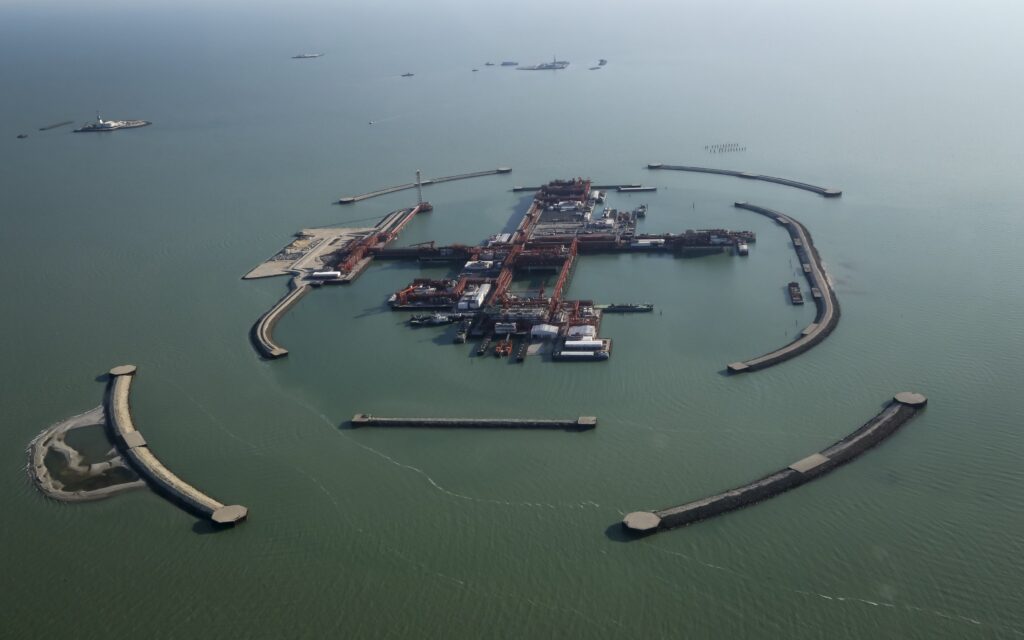
The hopes of the government and shareholders of the North Caspian project to start a full-scale development of Kashagan could be postponed for a long time. It may be required to fully restore the operation of the giant oil and gas field аrom 6 months to 1 year and possibly more.
The gas leak at Bolashak oil and gas treatment facility led to the production stop. It occurred due to corrosion of the pipeline which did not pass the appropriate quality test. The mistake was made at the stage of construction of the plant and was not revealed by the consortium later. This means that a complete revision of the entire Bolashak production facility may be required.
What happened
On August 3, the North Caspian Operating Company stopped the operation of Bolashak plant due to the detection of signs of a gas leak at the plant. According to the operator gas detectors detected the leak and the pressure was released on the flares.
“The incident did not cause any harm to people’s health,” the consortium stated but did not mention the potential damage the consortium’s shareholders as well as the country’s budget as a result of the problem with the oil and gas production. The gradual resumption of production began on the night of 9/10 August. Oil production is only 100 thousand barrels per day (b/d) which is four times less than it was before the accident (400 thousand b/d).
Sources in the industry told to Petrocouncil.kz that at least two events occurred at the project this year which demonstrated problems with the operation of the facility. First, a problem was identified in one of the gas re-injection compressors manufactured by Nuovo pignone in Florence (Italy) where wrapping paper was found inside the compressor and forgotten to be removed by an NCOC contractor.
Then, due to corrosion and sulfide cracking a part of the slug catcher pipe cracked (reservoir equipment in which gas or liquid plugs collect at the outlet of the pipeline).
This pipeline was found to have failed the Sulfide and Hydrogen Stress Corrosion Cracking test (SSC and HIC). They are not listed in the factory test certificate and such tests must be made by the manufacturer. The same thing happened with pipelines that broke back in 2013. Then the pipelines connecting Kashagan and Bolashak failed as a result oil production that had just begun was stopped for 3 years, until November 2016.
It turns out that even after the pipelines were damaged in 2013 (used to make the slug catcher) they were not tested for hardness although this was the main reason for that accident. Only the welds on the slug catcher were tested in 2014-2015 although it had to be changed.
According to an export familiar with the situation without confirmation that the pipelines have passed the necessary tests it is dangerous to run the slug catcher again as this can lead to a second damage. The assessment of the condition of this equipment, its replacement may take about six months.
Repairing a slug catcher means that each pipe will need to be changed, welded, weld tested and pressure tested. Even selective replacement of damaged pipes will take a long time but when the damage is confirmed in several places, a complete replacement of the equipment is needed. The operator does not currently have such a quantity of material in such quality with such specifications. Consortium needs to order them, test, deliver, install, etc.
Given the emerging risks the republic may strengthen control and requirements for this work. The incident demonstrated that a full examination of industrial safety is needed both onshore and offshore.
According to our information during the inspection damage was found in other lines of the slugcatcher, (there are 24). For example, a significant amount of sludge was found in one of the pipelines. It is possible that the problem has the much bigger scale.
Thus, the consortium urgently tries to resolve the issue and engages one of the major Italian EPC contractor (out of tender) to repair and replace the line. This company has begun to bring Indian workforce to Karabatan.
Who is guilty?
The local specialist who worked at Kashagan or Karabatan (Bolashak) knows that the production facilities were built with delays, with poor quality and increased the project budget.
The source who worked as a cable tray installer on D Island described the poor production performance (how they installed the same line several times without explanation) and nothing has changed except that the work was going on and the money spent.
There are legends about the construction of Bolashak facility in Atyrau where the operator of the construction phase was the Italian Agip KCO which was accused of multimillion-dollar fraud in 2010. At that time, the financial police reported that the company accounted for the same expenses for the construction and installation work performed at the facility (Comprehensive oil and gas treatment plant at the Bolashak plant) twice in the amount of $110 million. Subsequently, this amount was planned to be reimbursed at the expense of oil and gas produced.
It is unlikely the coincidence that the current situation that begun during the construction of Bolashak facility is being revealed. How safe is to work in this facility? Our sources report that the gas leak was detected firstly by a worker (not by a detector) and only then the alarm was turned on. If detector did not work at the facility, expensive compressors and pipelines were damaged, it could be the right time to demand from the one who built it? Especially if more than $50 billion was spent on this mega construction.
In 2021 NCOC reported the successful completion of its pilot development period and production increased to 400,000 bpd. A plan for the full-scale development of Kashagan has been approved and the implementation of the second stage of the field development by 2030 should increase production to 700,000 barrels per day. There is an agreement with a third party (QazaqGaz) on the processing of raw gas. It remains only to start the project. The expansion of Kashagan was supposed to help employ thousands of Kazakhs demobilized from Tengiz after the completion of the FGP project.

